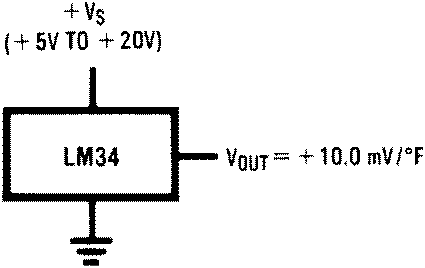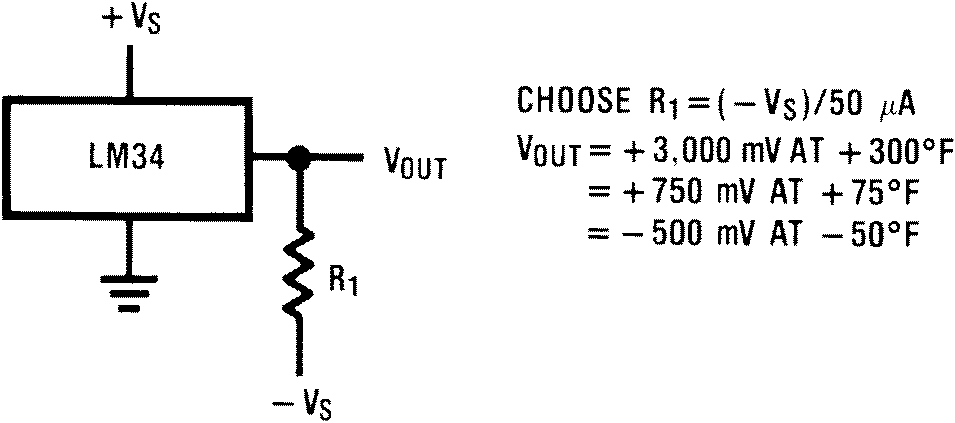SNIS161D March 2000 – January 2016 LM34
PRODUCTION DATA.
- 1 Features
- 2 Applications
- 3 Description
- 4 Revision History
- 5 Pin Configuration and Functions
- 6 Specifications
- 7 Detailed Description
- 8 Application and Implementation
- 9 Power Supply Recommendations
- 10Layout
- 11Device and Documentation Support
- 12Mechanical, Packaging, and Orderable Information
Package Options
Mechanical Data (Package|Pins)
Thermal pad, mechanical data (Package|Pins)
Orderable Information
1 Features
- Calibrated Directly in Degrees Fahrenheit
- Linear 10.0 mV/°F Scale Factor
- 1.0°F Accuracy Assured (at 77°F)
- Rated for Full −50° to 300°F Range
- Suitable for Remote Applications
- Low Cost Due to Wafer-Level Trimming
- Operates From 5 to 30 Volts
- Less Than 90-μA Current Drain
- Low Self-Heating, 0.18°F in Still Air
- Nonlinearity Only ±0.5°F Typical
- Low-Impedance Output, 0.4 Ω for 1-mA Load
2 Applications
- Power Supplies
- Battery Management
- HVAC
- Appliances
3 Description
The LM34 series devices are precision integrated-circuit temperature sensors, whose output voltage is linearly proportional to the Fahrenheit temperature. The LM34 device has an advantage over linear temperature sensors calibrated in degrees Kelvin, because the user is not required to subtract a large constant voltage from its output to obtain convenient Fahrenheit scaling. The LM34 device does not require any external calibration or trimming to provide typical accuracies of ±1/2°F at room temperature and ±1-1⁄2°F over a full −50°F to 300°F temperature range. Lower cost is assured by trimming and calibration at the wafer level. The low output impedance, linear output, and precise inherent calibration of the LM34 device makes interfacing to readout or control circuitry especially easy. It can be used with single power supplies or with plus and minus supplies. Because the LM34 device draws only 75 µA from its supply, the device has very low self-heating, less than 0.2°F in still air.
The LM34 device is rated to operate over a −50°F to 300°F temperature range, while the LM34C is rated for a −40°F to 230°F range (0°F with improved accuracy). The LM34 devices are series is available packaged in hermetic TO-46 transistor packages; while the LM34C, LM34CA, and LM34D are available in the plastic TO-92 transistor package. The LM34D device is available in an 8-lead, surface-mount, small-outline package. The LM34 device is a complement to the LM35 device (Centigrade) temperature sensor.
Device Information(1)
| PART NUMBER | PACKAGE | BODY SIZE (NOM) |
|---|---|---|
| LM34 | SOIC (8) | 4.90 mm × 3.91 mm |
| TO-92 (3) | 4.30 mm × 4.30 mm | |
| TO-46 (3) | 4.699 mm × 4.699 mm |
- For all available packages, see the orderable addendum at the end of the data sheet.
Basic Fahrenheit Temperature Sensor (5°F to 300°F)

Full-Range Fahrenheit Temperature Sensor
